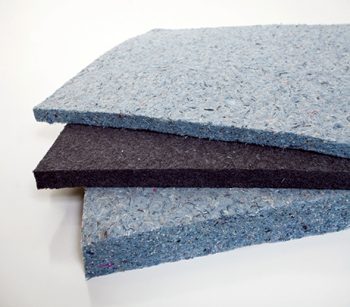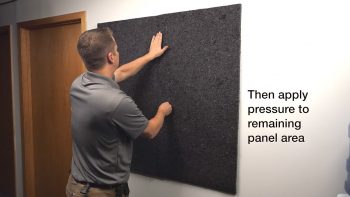Installing Echo Eliminator Wall Panels
If left acoustically untreated, large, open spaces like some restaurants, school gyms and cafeterias, shopping malls, or sporting venues, to name a few, can generate tremendous volumes of echo and reverberation, making individual as well as public communications very difficult if not outright irritating and hazardous to our health.
Public address or speaker systems often exacerbate the problem by pumping more sound energy into highly reflective acoustical environments, thereby only contributing to the cacophony.
Even small spaces with highly reflective surfaces can have too much echo and reverberation, causing similar problems, with similar solutions.
Using Echo Eliminator Wall Panels to Absorb Excess Sound Energy

Whether you are working on a small, large, domestic, or public project, you can realize fantastic benefits by installing Echo Eliminator Wall Panels to absorb excess sound reflections. They are available in both wall panel and hanging baffle formats.
Made from recycled, Bonded Acoustical Cotton (B.A.C.), Echo Eliminator is currently one of the most cost effective acoustical absorbing material on the market.
Ideal for noise control applications, Echo Eliminator is typically used to treat school gyms, classrooms, lunch rooms, or any situation in which high-performance noise control is needed. Echo Eliminator panels also qualify for LEED™ credits, and they’re non-flammable Class A fire rated as well as 100% recyclable.
Installing Echo Eliminator Wall Panels
Below, you will find step-by-step instructions on how to install Echo Eliminator Wall Panels. For visual reference, you can also watch our video, Installing Echo Eliminator Panels.
Materials and Equipment
- Echo Eliminator Wall Panels
- Noise S.T.O.P.™ Contact Adhesive Spray
- Titebond GREENchoice Panel & Subfloor Adhesive
- Caulking gun
- Utility knife
- Measuring tape
- Marking pencil
- Level
Determine the area where the panel is to be installed on the wall surface.
Measuring and marking the wall to place your panel in the desired location
- Measure and mark distance to top of panel from ceiling – OR – from center of desired panel location
- Measure and mark distance to one edge (side/horizontal) of panel location from nearest boundary (door frame, adjacent wall, etc.)
- Mark horizontal line at top mark with a level (line length should be slightly shorter than panel dimension)
- Mark the vertical line at edge distance with a level (line length should be slightly shorter than panel dimension)>
Applying adhesive to the back of the panel

- Use a caulking gun to lay a bead of adhesive around the entire perimeter, about 1-1/2” from the edge with Titebond GREENchoice Panel & Subfloor Adhesive on the back surface of the panel.
- Lay a bead of Panel adhesive from corner to corner within the previously-applied rectangular adhesive perimeter creating an “X” pattern in the center.
- Apply Noise S.T.O.P.™ Contact Adhesive Spray inside the 4 empty spaces between the adhesive lines of the perimeter and “X” adhesive beads you just applied. Note: DO NOT allow Contact adhesive to overspray Panel adhesive bead lines!
- Allow the spray adhesive to set for 4 minutes before attaching the panel to the wall.
Attaching the panel to the wall
- Align panel edges to side vertical line and top horizontal line.
- Apply even and firm pressure on the side & top to set edge adhesive.
- Apply even and firm pressure to set adhesive for remaining area.
Conclusion
Whatever your acoustical project is, we can help you with know-how, experience, design ideas, and a wide range of leading-edge acoustical products.
For further blogs, tutorials, and product descriptions, please visit us at AcousticalSurfaces.com or contact us. One of our representatives will always be happy to help you with any questions you may have.



